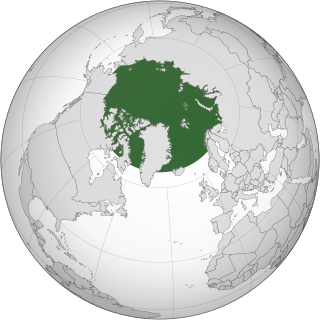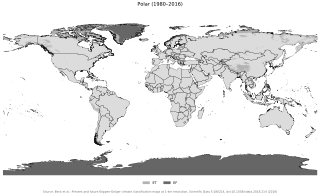Related Research Articles

The Arctic is a polar region located at the northernmost part of Earth. The Arctic consists of the Arctic Ocean, adjacent seas, and parts of Canada, Danish Realm (Greenland), northern Finland (Lapland), Iceland, northern Norway, Russia, northernmost Sweden and the United States (Alaska). Land within the Arctic region has seasonally varying snow and ice cover, with predominantly treeless permafrost containing tundra. Arctic seas contain seasonal sea ice in many places.

The polar climate regions are characterized by a lack of warm summers but with varying winters. Every month a polar climate has an average temperature of less than 10 °C (50 °F). Regions with a polar climate cover more than 20% of the Earth's area. Most of these regions are far from the equator and near the poles, and in this case, winter days are extremely short and summer days are extremely long. A polar climate consists of cool summers and very cold winters, which results in treeless tundra, glaciers, or a permanent or semi-permanent layer of ice. It is identified with the letter E in the Köppen climate classification.

The polar regions, also called the frigid zones or polar zones, of Earth are the regions of the planet that surround its geographical poles, lying within the polar circles. These high latitudes are dominated by floating sea ice covering much of the Arctic Ocean in the north, and by the Antarctic ice sheet on the continent of Antarctica and the Southern Ocean in the south.
Feminist theory is the extension of feminism into theoretical, fictional, or philosophical discourse. It aims to understand the nature of gender inequality. It examines women's and men's social roles, experiences, interests, chores, and feminist politics in a variety of fields, such as anthropology and sociology, communication, media studies, psychoanalysis, political theory, home economics, literature, education, and philosophy.
Eleanor Antin is an American performance artist, film-maker, installation artist, conceptual artist and feminist artist.

The Scott Polar Research Institute (SPRI) is a centre for research into the polar regions and glaciology worldwide. It is a sub-department of the Department of Geography in the University of Cambridge, located on Lensfield Road in the south of Cambridge.
Michele Faith Wallace is a black feminist author, cultural critic, and daughter of artist Faith Ringgold. She is best known for her 1979 book Black Macho and the Myth of the Superwoman. Wallace's writings on literature, art, film, and popular culture have been widely published and have made her a leader of African-American intellectuals. She is a Professor of English at the City College of New York and the Graduate Center of the City University of New York (CUNY).
Deborah Kass is an American artist whose work explores the intersection of pop culture, art history, and the construction of self. Deborah Kass works in mixed media, and is most recognized for her paintings, prints, photography, sculptures and neon lighting installations. Kass's early work mimics and reworks signature styles of iconic male artists of the 20th century including Frank Stella, Andy Warhol, Jackson Pollock, and Ed Ruscha. Kass's technique of appropriation is a critical commentary on the intersection of social power relations, identity politics, and the historically dominant position of male artists in the art world.

Griselda Frances Sinclair Pollock is an art historian and cultural analyst of international, postcolonial feminist studies in visual arts and visual culture. Since 1977, Pollock has been an influential scholar of modern art, avant-garde art, postmodern art, and contemporary art. She is a major influence in feminist theory, feminist art history, and gender studies. She is renowned for her innovative feminist approaches to art history which aim to deconstruct the lack of appreciation and importance of women in art as other than objects for the male gaze.

Art history is the study of aesthetic objects and visual expression in historical and stylistic context. Traditionally, the discipline of art history emphasized painting, drawing, sculpture, architecture, ceramics and decorative arts; yet today, art history examines broader aspects of visual culture, including the various visual and conceptual outcomes related to an ever-evolving definition of art. Art history encompasses the study of objects created by different cultures around the world and throughout history that convey meaning, importance or serve usefulness primarily through visual representations.
Claire Colebrook, is an Australian cultural theorist, currently appointed Edwin Erle Sparks Professor of English at Pennsylvania State University. She has published numerous works on Gilles Deleuze, visual art, poetry, queer theory, film studies, contemporary literature, theory, cultural studies and visual culture. She is the editor of the Critical Climate Change Book Series at Open Humanities Press.
Connie Samaras is a Los Angeles-based artist who works mostly in photography and video. She is best known for her speculative landscape series.
Feminist aesthetics first emerged in the 1970s and refers not to a particular aesthetic or style but to perspectives that question assumptions in art and aesthetics concerning gender-role stereotypes, or gender. Feminist aesthetics has a relationship to philosophy. The historical philosophical views of what beauty, the arts, and sensory experiences are, relate to the idea of aesthetics. Aesthetics looks at styles of production. In particular, feminists argue that despite seeming neutral or inclusive, the way people think about art and aesthetics is influenced by gender roles. Feminist aesthetics is a tool for analyzing how art is understood using gendered issues. A person's gender identity affects the ways in which they perceive art and aesthetics because of their subject position and that perception is influenced by power. The ways in which people see art is also influenced by social values such as class and race. One's subject position in life changes the way art is perceived because of people's different knowledge's about life and experiences. In the way that feminist history unsettles traditional history, feminist aesthetics challenge philosophies of beauty, the arts and sensory experience.
Feminist art criticism emerged in the 1970s from the wider feminist movement as the critical examination of both visual representations of women in art and art produced by women. It continues to be a major field of art criticism.

WACK!: Art and the Feminist Revolution was an exhibition of international women's art presented at the Museum of Contemporary Art, Los Angeles from March 4–July 16, 2007. It later traveled to PS1 Contemporary Art Center, where it was on view February 17–May 12, 2008. The exhibition featured works from 120 artists and artists' groups from around the world.
Cassils is a performance artist, body builder, and personal trainer from Montreal, Quebec, Canada now based in Los Angeles, California, United States. Their work uses the body in a sculptural fashion, integrating feminism, body art, and gay male aesthetics. Cassils is the recipient of a Guggenheim Fellowship, a Creative Capital Grant, a United States Artists Fellowship, a California Community Foundation Visual Artist Fellowship (2012), several Canada Council for the Arts grants, and the Rema Hort Mann Foundation Visual Arts Fellowship. Cassils is gender non-conforming, transmasculine, and goes by singular they pronouns.
Zachary Braiterman is an American philosopher, best known for writing on the topics of Holocaust theology, Jewish thought, aesthetics, and Jewish art. He is also a professor of religion at Syracuse University.
Catriona Moore is an Australian art historian, art theorist and academic.
Victoria Herrmann is an American polar geographer and climate change communicator. She is the Managing Director of The Arctic Institute, a National Geographic Explorer, and Assistant Research Professor at Georgetown University’s Walsh School of Foreign Service, where her research focuses on Arctic cooperation and politics and climate change adaptation in the US and US Territories.
References
- ↑ "Lisa Bloom - Center for Study of Women". UCLA. Archived from the original on 2015-09-10. Retrieved 2016-03-09.
- 1 2 "Gender on Ice". S&F Online. Barnard University, Barnard Center for Research on Women. 2008-09-01. Retrieved 2016-03-09.
- 1 2 Lisa Bloom, 2012. “Disappearing Ice and Missing Data: Visual Culture of the Polar Regions and Global Warming.” In Polli, A. and Marsching. J. (eds.), Far Fields: Digital Culture, Climate Change, and the Poles, Intellect Press, 117-142.
- 1 2 Lisa Bloom, 2015. “Witnessing Climate Change: Oil, Geopolitics and Landscapes of Invisibility,” for the anthology edited by Anna Stenport, Scott Mackenzie, and Lill-Ann Korber, “When Worlds Collide: Arctic Ecological Imagination.” (Rodopi, 2015).
- 1 2 Planetary Precarity and feminist environmental art practices in Antarctica.” Eds., Janet Wilson. Journal of Postcolonial Writing (Taylor and Francis), Volume 56, Issue 3, August 2020.
- 1 2 “At Memory’s Edge: Climate Trauma in the Arctic Through Film.” Eds., Subhankar Banerjee, TJ Demos and Emily Eliza Scott. The Routledge Companion to Contemporary Art, Visual Culture and Climate Change. Routledge, London, 2021, 194-203
- 1 2 "Gender on Ice". University of Minnesota Press. Retrieved 2016-03-09.
- 1 2 Jeanne Kay, “Ice Follies,” Women’s Review of Books 11 (7), 1994, 21-22.
- 1 2 "Nonfiction Book Review: Gender on Ice by Lisa Bloom". PublishersWeekly.com. Retrieved 2016-03-09.
- ↑ With Other Eyes: Looking at Race and Gender in Visual Culture (1999) http://www.upress.umn.edu/book-division/books/with-other-eyes
- ↑ Jessica Dallow , Essay Review "Art," Identity, and Difference: Three (double)takes on Visual Culture? With Other Eyes: Looking at Race and Gender in Visual Culture, edited by Lisa Bloom. NWSA Journal, Volume 15, no. 2 (Summer 2003), pp.135-143.
- ↑ Lisa Bloom, “True North: Isaac Julien’s Aesthetic Wager,” republished in German and English in Isaac Julien: True north : Fantôme Afrique, edited by Veit Görner and Eveline Bernasconi : [Distributed in North America by] D.A.P., Distributed Art Publishers, 2006. Catalog published in conjunction with the exhibition Isaac Julien--True north/Fantôme Afrique, held at Kestnergesellschaft, Hannover, Germany, June 23-Aug. 20, 2006; Lisa Bloom, “Arctic Spaces: Politics and Aesthetics in Gender on Ice and True North,” Nka: Journal of Contemporary African Artˆ, issue 26, Spring 2010, pp. 30-37.
- ↑ “Tableaux Vivants, Dying Empires: Eleanor Antin’s The Last Days of Pompeii, Roman Allegories and Helen’s Odyssey (2001-2007)" in a special issue on "Material Histories, n.paradoxa: international feminist art journal, volume 24, July 2009, pp. 13-21; and Lisa Bloom,"Writing Your Own Script: Revisioning the 1970s and the 1980s Through the Work of Eleanor Antin," in Eleanor Antin , eds. Howard N. Fox, Lisa E. Bloom, and Eleanor Antin. (New York and Los Angeles: Distributed Art Publishers in Conjunction with the Los Angeles County Museum ,1999), 159-189.
- ↑ Lisa Bloom, “Connie Samaras’ Futures in Extreme Environments: Toward a New Aesthetics of Daily Life and Survival.” For the exhibition catalogue edited by Irene Tastsos, Connie Samaras: Tales of Tomorrow. (DAP Press, 2013).
- ↑ Lisa Bloom, “Extreme Temperatures: The Work of Nathalie Talec,” for the exhibition catalogue: Nathalie Talec: The One Who Sees Blindly, Yerba Buena Center, San Francisco, April 2012.
- ↑ Lisa Bloom, “When Ice is Just Ice: Gender and the Everyday in the Arctic Art of Katja Aglert.” Published for the Winter Event – Antifreeze, published in (Art and Theory, Stockholm, Sweden, March, 2014). 127-133.
- ↑ Lisa Bloom, “Negotiating Feminisms in Contemporary Asian Women’s Art.” In ed., Amelia Jones Feminism and Visual Culture, 2nd edition, London: Routledge, 2010.
- ↑ Lisa Bloom, "Gender, Nationalism, and Internationalism in Japanese Contemporary Art: Some Recent Writings and Work." in n.paradoxa: international feminist art journal, vol. 5 (London, England, 2000), 35-43.
- ↑ Rachel Garfield, “A Bifurcated History (And So it Goes On),” Art History 30(5),December 2007, 785-91. http://onlinelibrary.wiley.com/doi/10.1111/j.1467-8365.2007.00574_5.x/abstract
- ↑ “Ghosts of Ethnicity: Jewish Identities in American Feminist Art,” in Daniel Rosenberg, Practicing Jews: Art, Identity and Culture, (University of Wisconsin, Madison, 2009).
- ↑ Lisa Bloom, “Barbies’s Jewish Roots: Jewish Women’s Bodies and Feminist Art,“ in Nathan Abrams (ed.) Jews and Sex, London, (Nottingham: Five Leaves, 2008), 121-137.